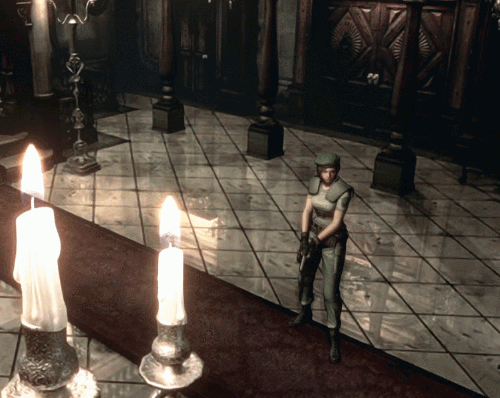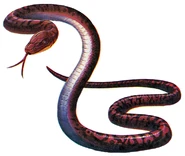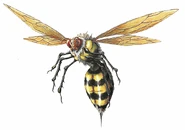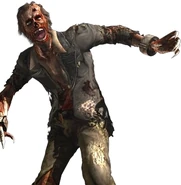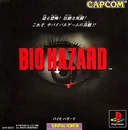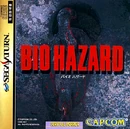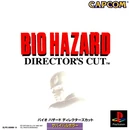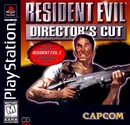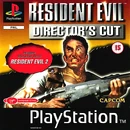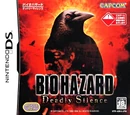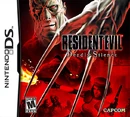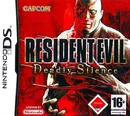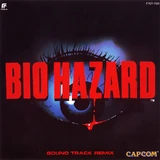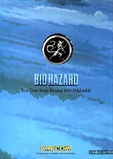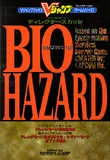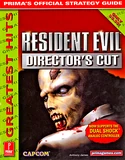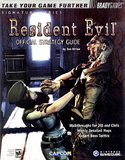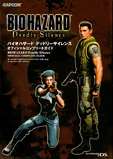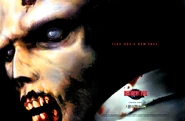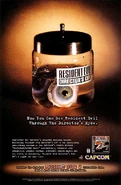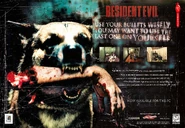Resident Evil (Biohazard in Japan) is a survival horror video game developed by Capcom and directed by Shinji Mikami, it is the inaugural title in the Resident Evil series. It was initially released in 1996 exclusively for the Sony PlayStation and has subsequently been ported to the Sega Saturn and PC. A Director's Cut was also released.
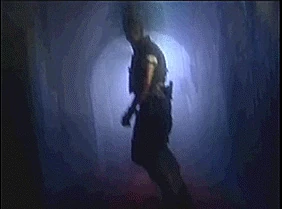
Several remakes and updates has been made of the game. In 2002, a remake of the game was released for the Nintendo GameCube featuring new graphics, voice acting and many significant gameplay changes. An enhanced Nintendo DS port of the original (titled Deadly Silence) was released in early 2006. The GameCube remake was ported to the Wii in 2008.
Resident Evil was the first game to be dubbed "survival horror", a term coined by Capcom to promote the title. Whether it was the first game in the survival horror genre is disputed. While many people consider Alone in the Dark (a 3D horror PC game released in 1992) to be the first, Resident Evil was the first in the genre to officially bear the title.
The Dead horror movies by George A. Romero are known to have been a major influence for Resident Evil. Another major influence is Capcom's own Sweet Home (a horror adventure NES game released in 1989). The game inspired Capcom's own Dead Rising series, albeit in a different tone and manner.
Gameplay
Unlike subsequent Resident Evil games, the first game had a live-action opening and endings in the style of a B-grade horror movie. The opening footage in Western releases was significantly re-cut to exclude much of the gore. Although Capcom had intended to include the complete and uncensored version of the intro in the later releases, only the PC, some North American and European Sega Saturn releases, and the German and French PAL PlayStation Director's Cut releases contained the original FMV.
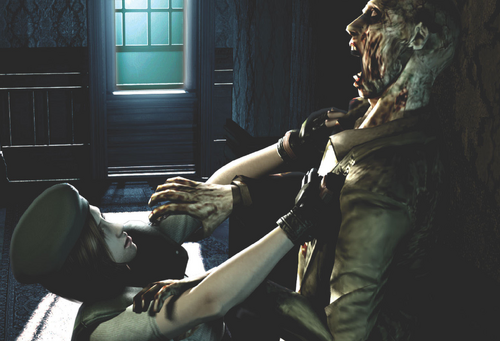
U.S. Remake Cover Art
The gameplay environment consists of polygonal 3-D characters placed over pre-rendered 2-D backgrounds. As such, the game relies on pre-determined camera angles as opposed to a real-time camera. As a result, the game uses a "tank-like" control scheme. Instead of the player moving the character in the direction pushed on the control stick, the character instead moves forward by pressing up, backwards by pressing down and will turn on the spot by pushing left or right directional buttons. Many of the series' detractors have criticized this control scheme, claiming that it is confusing and unsuitable for a third-person action game. Fans however, defend it, arguing that a conventional third-person control scheme would be limited and unwieldy when used in conjunction with the pre-rendered camera angles prevalent in the majority of the series' titles.
These often imaginative camera angles are used to convey an ominous, cinematic feel to the player, claimed by the developers to have been impossible to achieve with standard 3D technology of the period. The pre-rendered backgrounds would also allow the developers to add a level of detail previously impossible for 3-D technology of the time.
The player fights enemies by arming the character with a weapon. When attacking, the player remains static and can turn their character and aim their weapon up or down. Initially, the only weapons available to the player are a combat knife and a Beretta 92FS, but later in the game, more weapons become accessible to the player such as the Remington M870 and a Colt Python. Ammunition for firearms is severely limited.
The player must survive by fending off or evading the various monsters that populate the mansion. The most common enemies in the game are zombies, which are slow-moving and easy to outrun, but hard to avoid in tight corners. During later sections of the game, the player must also fight against zombie dogs (known as Cerberus), Hunters, Chimeras and Web Spinners, as well as small enemies such as crows, wasps and adders. The player must also fight against bosses such as Yawn (a giant snake), a mutated plant, a giant spider, a shark and the extremely powerful Tyrant.
Health is restored by using first-aid sprays or healing herbs. Of the two, healing herbs are more common and restore a portion of the player's health, while first-aid sprays are more scarce, but will restore the player's health completely. There are three types of healing herbs available: the Green Herb for restoring health, the Blue Herb which cures poison, and the Red Herb which can't be used by itself, but will triple the healing power of a green herb when mixed with one. The player can mix herbs for up to six usable combinations.
The player must navigate through the mansion by picking up various keys and items which are integral to the game's progress, while solving puzzles along the way. The player has a limited capacity for carrying items and this enforces the need to carry only essential items in order to have space for new items. As such, storage boxes are available for the player to place any item for later use.
The player can save progress by locating a typewriter and using an ink ribbon to save gameplay data. Ink ribbons are available in a limited quantity, forcing the player to think carefully about whether they have made enough progress to justify saving the game. This method has also been criticized by many, but designer Shinji Mikami defended this aspect by arguing that it increases the tension level of the game.
There are also various documents available, which provide the solutions to certain puzzles or simply further divulge the plot.
Characters

Deadly Silence Japan Cover Art by Shinkiro
- Jill Valentine
- Chris Redfield
- Rebecca Chambers
- Barry Burton
- Albert Wesker
- Brad Vickers
- Joseph Frost
- Richard Aiken
- Edward Dewey
- Enrico Marini
- Forest Speyer
- Kenneth J. Sullivan
- Kevin Dooley
Enemies
- Zombies
- MA-121 Hunter Alpha
- Cerberus
- Crows
- Plant 42
- Giant Spider
- Chimeras
- Neptune & offspring
- Yawn
- T-002 Tyrant
- Crimson Heads - (remake only)
- Lisa Trevor - (remake only)
- Adder - The Adder is a small snake that was not mutated extensively by the T-Virus, and that holds none of the characteristics of more enhanced B.O.W.s, such as Yawn. It has a poisonous bite, in addition to being small and hard to hit.
- Wasp
- Elder Crimson Head - (remake only) - The Umbrella Researchers studied a prototype B.O.W where the host underwent further metamorphosis from the T-virus. Its body experienced increased muscle development as well as increased speed and agility. It was named "Crimson Head" not only because of its appearance, but its high level of aggression and ferociousness that left four researchers dead. Since it was too dangerous for any further observation, the scientists had no choice but to freeze it and conceal it inside the Spencer estate's backyard cemetery.
Story

U.S. Sega Saturn Cover Art
The original game opens on the evening of July 24, 1998 in the fictional Raccoon City where a number of grisly murders have taken place on the outskirts of town. Victims were attacked in their homes by a group of assailants, who left evidence of cannibalism. Local law enforcement sends in the S.T.A.R.S. Bravo Team. After contact is lost, the Alpha Team is sent out to find Bravo Team and to continue the investigation. Alpha Team locates the downed Bravo Team helicopter, but there is no sign of survivors; only a severed hand is found. While searching the area for further clues, Alpha Team is attacked by ferocious dogs, which kill one of the team's members, Joseph Frost. Alpha's helicopter pilot, Brad Vickers, suddenly lifts off and abandons the team. Pursued by the violent dogs who killed their colleague, Alpha Team is forced to seek refuge within a nearby mansion, believed to be abandoned.
With the dogs roaming the outside of the building, the four remaining Alpha Team members (Jill Valentine, Chris Redfield, Barry Burton and Albert Wesker) are besieged within. A gun shot rings out, to which the player's selected character moves to investigate. At this point, the player takes control of the character and begins to explore the mansion. One of the first discoveries to be made is a member of Bravo Team, Kenneth Sullivan, being eaten by a zombie. The character eventually finds the mansion to be riddled with puzzles, traps and horrors; anything but abandoned. Scattered documents and files suggest that a series of illegal experiments and criminal activities were being undertaken on the property by a clandestine research team, under the authority and supervision of pharmaceutical conglomerate Umbrella Incorporated. The creatures roaming the mansion and surrounding region are the results of these experiments, which have exposed the mansion's personnel and various animals and insects to a highly contagious and mutagenic biological agent known as the "T-Virus" (hence the Japanese title, "Biohazard").
After navigating a series of tunnels, passageways and buildings, the player discovers a secret underground laboratory containing detailed records of the Umbrella Corporation's experiments. In the lab, Albert Wesker reveals that he is a double agent working for Umbrella and releases the "Tyrant T-002", a giant humanoid monster created through prolonged exposure to the T-Virus. Upon release, the Tyrant immediately impales Wesker on its elongated claws. The player then apparently slays the Tyrant. A self-destruct program is triggered soon after. After the player calls for a rescue chopper, the Tyrant bursts through the roof of the lab onto the chopper landing pad and attacks. Suddenly resistant to bullets, the Tyrant is finally slain when the chopper pilot, Brad Vickers, drops a rocket launcher and the player uses it to completely destroy the creature. The player escapes in the chopper and the game ends.
The ending sequence varies, depending on choices made by the player as he/she explores the mansion. So long as the player escapes with both teammates, the ending plays out as described above. Rescuing only one or neither teammates changes the outcome.
Other Versions
Versions of the Original

Resident Evil 1 Intro Uncut
Uncut Intro
Saturn Version
In 1997, Capcom released a Sega Saturn version of Resident Evil on July 27 in Japan and on August 31 in North America, a few months prior to the release of Resident Evil: Director's Cut for PlayStation. This version has some graphical differences from the PlayStation version, such as more detailed backgrounds but lower resolution for cut-scenes, and new exclusive content not found in any other version of the game as compensation.
- Battle Game - A new minigame becomes available after completing the main game. In the Battle Game, the player's objective is to go through a series of areas from the main game and clear each stage of monsters (while trying to conserve ammo). The player is graded at the end based on their time. This minigame is often considered as a precursor to the various minigames included in subsequent installments such as the Extreme Battle Mode in Resident Evil 2 and Leech Hunter in Resident Evil 0.
- New Costumes - Alternate outfits for Chris and Jill are also available in addition to the ones from the original PlayStation version.
- New Monsters - New creatures appear at certain points during the main game, including a new species of Hunter (called Ticks) within the underground tunnels and a second Tyrant within the lab. In addition, new monsters are present in Battle Game, including a golden Tyrant and a zombie version of Wesker.
- Uncut FMV Files - Accidentally, some U.S. and European versions of the game contained the original, uncut, colored intro with Kenneth's head scene and Chris's original bad ending.
Certain copies of the game in Japan came packaged with the book The True Story Behind Biohazard, which contained transcripts of Trevor's Letters, the original novel Biohazard: The Beginning by Hiroyuki Aniga and an interview with Shinji Mikami.
Director's Cut
Resident Evil was re-released on the Playstation under the title Resident Evil: Director's Cut. Director's Cut contained, in addition to the original version of the game, a new "Arrange" mode with various changes made to the game.
- New Costumes - The default outfits for Chris and Jill (as well as Rebecca) are different in Arrange Mode. The player can also change to their character's original outfit by going to the dressing room within the mansion's first floor.
- New Camera Angles - Several areas and a few cutscenes are now viewed from different angles.
- Different Item and Enemy Placement - Many of the key items in the game were relocated and placed in different areas. Many of the enemies were also relocated, with some areas featuring more enemies than they did in the original.
- New Handgun - A new silver-cased version of the Beretta M92FS replaces the black-colored version from the original game. The Custom Beretta (said to be "one of a thousand") has a faster firing rate, and the ability to randomly kill certain enemies with one shot.
- New Enemy - A zombie version of Forest Speyer appears as an enemy in the mansion's terrace, instead of the usual pack of crows. In addition, there are also "Hyper Zombies" that resemble regular zombies, but are faster and completely resistant to shotgun blasts to the head.
- Beginner Mode - The player's life and weapons' firepower are increased and the quantities of ammunition and ink ribbons are doubled. The auto-aiming feature that was missing in the English-language version of the original was also restored, allowing the player to lock onto targets with the press of a button.
Interestingly, the edited cut-scenes remain censored in this version.
Deadly Silence
An enhanced Nintendo DS port of the original Resident Evil, titled Resident Evil: Deadly Silence, was made to commemorate the tenth anniversary of the series. Deadly Silence includes a "Classic Mode," the original game with minimal enhancements and touch-screen support, as well as a "Rebirth Mode" containing a greater amount of enemies and a series of new puzzles that make use of the hardware's unique features.
The game makes use of the dual screen display with the top screen used to display the map, along with the player's remaining ammunition and health (determined by the color of the background); while the bottom screen displays the main gameplay, and can be switched to show the player's inventory. The graphics were mildly enhanced, and the game also include updated play mechanics; the 180-degree turn introduced in Resident Evil 3: Nemesis, along with the knife button, and tactical reload from Resident Evil 4. The updated controls are applicable to both Classic and Rebirth modes. Dialog and loading screens can be skipped. The live-action footage was still censored, even in the game's Japanese release, however the scene showing Kenneth's decapitated head was kept.
In "Rebirth," new puzzles are added which make use of the system's touch-screen to solve them. "Knife Battle" sequences, viewed from a first-person perspective, are also added in which the player must fend off incoming enemies by swinging the knife via the stylus. One particular puzzle requires the player to resuscitate an injured comrade by blowing into the built-in microphone. The player can also shake off enemies by using the touch screen and performing a melee attack.
The game also includes wireless support (LAN-only) for up to four players with two different multiplayer game modes. The first is a cooperative mode in which each player must help each other solve puzzles and escape the mansion together. The other is a competitive mode in which the objective is to get the highest score out of all the players by destroying the most monsters, with the tougher monsters being worth more points. There are three playable multiplayer stages and nine playable characters.
Rebirth
In 2002, the original game was completely redone from the ground up, titled Resident Evil (biohazard in Japan) and informally known as Resident Evil Rebirth, and released on the GameCube. This was part of an exclusivity agreement between Capcom and Nintendo that spanned three new games (which also included Resident Evil 0 and Resident Evil 4).
The title includes a variety of new gameplay elements, environments, and story details as well as state of the art visuals. Shinji Mikami stated that the remake is "70% different from the original."

Resident Evil Remake Intro
Remake Intro
The game is notable for its nearly photo-realistic environments, all of which are pre-rendered. The remake featured all-new graphics and sound, and also incorporated gameplay elements from the later installments (such as the use of body language and the 180-degree turn), introduced a new running style which was also used in Resident Evil 0, and several new areas and rooms were added. The overall plot remains largely unchanged. The original live-action FMV segments are replaced by CG versions, and the voice acting was completely re-recorded with new actors. The script was rewritten to have a more serious tone and improved translation, as opposed to the cheesy B-movie dialogue and "Engrish" script of the original. Gameplay mechanics are largely the same, although most of the puzzles have been changed and the player can equip a defensive weapon that can be used when seized by an enemy.
Additionally, the remake features many unlockable modes, secrets, and various endings not found in the original. It also restores the George Trevor subplot, and splices other main characters of the Resident Evil plot, such as William Birkin and Alexia Ashford into the game's story, and is generally considered to be the final, "canonical" version of the original game.
This version was released on the Nintendo Wii in Japan in 2008 and in the U.S. on June 23, 2009 as Resident Evil Archives: Resident Evil. An HD remastered edition will be released on PlayStation 3, PlayStation 4, Windows, Xbox 360 and Xbox One in early 2015. The game enhances the GameCube version with 1080p visuals and remastered 5.1 surround sound, with additional options for analog controls and widescreen ratio. The game is being digitally released in North America and Europe. However, a PlayStation 3 retail version will be available exclusively in Japan.
Music
The Biohazard Original Soundtrack Remix was composed by Makoto Tomozawa, Akari Kaida, and Masami Ueda for the video game Biohazard, known as Resident Evil outside Japan. All compositions were rearranged by Makoto Tomozawa and mixed in QSound technology.
See Also
Credits
Resident Evil [Saturn]
- Cast
Chris Redfield: Charlie
Jill Valentine: Inezh
Barry Burton: Gregory
Rebecca Chambers: Linda
Albert Wesker: Eric
Joseph Frost: Jason
- Original Version Staff
- Planner
System Plan/Camera Works: Hideki Kamiya, Hiroki Kato, Kazunori Kadoi, Koji Oda, Satoshi Murata
Scenario: Kenichi Iwao
Event Director: Kazuhiro Aoyama, Takashi Nakaya, Masaaki Yamada
Background Story: Yasuki Saga
- CG Team
Background Model: Ippei Masuda, Satoru Nishikawa, Junko Yasuda, Tetsuya Shiraishi, Yasuyuki Matsunami, Keiichi Nabetani, Motoji Fujita, Atsuko Hamada
Character Model/Motion: Jun Takeuchi, Satomi Hayashi
Character Texture: Yuji Ishihara, Ryoji Shimogama, Hideaki Katagiri
- Graphic
BG/Object Texture: Chie Nishida, Hideyuki Koitabashi, Nobuaki Yamazaki, Jun Ogawa, Yasushi Hiraoka, Hidesato Sueyoshi, Manabu Takeda, Ippei Yamamoto, Yoshihiro Nakamoto, Naomi Takemoto
Icon Design: Shizuyo Ukai
Lettering: Aya Nishio
Effect: Yoshiaki Teshima, Satomi Tsubota
- Sound
Composition/Arrangement: Makoto Tomozawa, Akari Kaida, Masami Ueda
Sound design: Ippo Yamada, Hideaki Utumi
- Software Engineer
System: Yasuhiro Anpo
Cockpit: Takayuki Inoue
Sound System/Effect: Tomohito Ishihara
Player/Enemy: Katsutoshi Karatsuma, Hiroyuki Kobayashi, Yuji Hagiyama, Shigeki Niino
Event: Syuichiro Chiboshi, Kiyohiko Sakata, Noriyuki Ohtani, Takeshi Enomoto
Room Editor: Hidekazu Shingaki, Michinori Kataoka, Hideaki Motozuka
Movie: Hiroaki Watanabe
Authoring System: Atsushi Manobe, Takashi Hashimoto, Mitsunori Sakano
Base Program: Kazushi Sano, Takahiro Yamada
- Design
Plot: Takahiro Arimitsu
Rooms: Yuko Nakadai, Mitsuru Kuwahata, Kazuki Nakayama
Characters: Isao Ohishi
Enemies: Toru Nakayama, Kazunori Shimizu, Yorinao Matsuura
Publicity: Masako Honma
- Super Visor
Masahiko Kurokawa
- Special Thanks
Tsuyoshi Wakuta, Takuya Shiraiwa, Shigeomi Okamura
- Film Crew
Producer: Norihiro Nishitani
Production manager: Masanari Takano
Director: Mitsuhisa Hosoki
CG movie: Seiji Namba
Director of Photographer: Iwao Hara
Lighting: Takahisa Aida
Make-up: Shoko Kato
Styling: Wakana Hara
Casting: Toru Tateishi
Narrator: Ward. E. Sexton
- Plan Cooperation
- Production
Center Field., Ltd.
- Special Effects
Gives Co., Ltd.
- Post Production
Vision Universe Co., Ltd.
- Music
M on M inc./Music Expedition Co., Ltd.
‒ with Cooperation From ‒ F・M・C
General Producer: Tokuro Fujiwara
Producer: Masayuki Akahori
Director: Shinji Mikami
- Saturn Version Staff
- 3DCG Team
Character Model/Motion/Object/Texture Conversion: Yoshihisa Shimizu, Ryosuke Tei, Naomi Anzai, Misao Kobayashi, Miho Sadogawa, Masahiro Sato
- 2DCG Team
Chief: Yoshitaka Maki
BG Saturn Conversion: Yoshiyuki Miyazawa, Yuki Izumi, Shingo Inaba, Kazuhiro Ogawa, Keiko Arakawa, Genki Kaneko
Icon Design: Yoshiyuki Miyazawa
- Sound Team
Sound Design: Tatsuya Kouzaki
Saturn Conversion: Naofumi Hataya, Tomonori Sawada, Seiro Okamoto
- Movie Team
Movie Compile: Yuji Sawairi, Hidehiro Kumagai
- Software Team
System: Yukihiko Tani
Sub System: Eiki Aizawa
Enemy/Event: Yuuiti Shiono, Masahiko Moriya
Sound/Movie: Tomoaki Fujituka
- Special Thanks
Kenei Unoki, Eiji Taki, Akira Nishikawa, Manabu Morinaga, Shinobu Shindo, Ryouichi Hasegawa
- Super Visor
Katsuji Aoyama, Masatoshi Totsuka
Technical Director: Hiroshi Fukuda
Director: Tomomi Endo
General Producer: Yoshiki Okamoto, Makoto Oshitani
Producer: Tatsuya Minami, Katsuhiro Hasegawa
Presented by: Capcom




